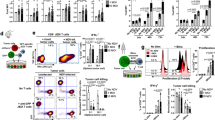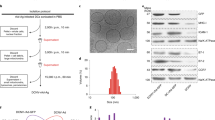Abstract
Dendritic cells (DC) are professional antigen-presenting cells capable of initiating a potent primary immune response, making them an attractive target for cancer immunotherapy. Flt-3 ligand (Flt-3L) is a haematopoietic growth factor that efficiently induces DC expansion in vivo. To achieve a more efficient and effective method of priming tumour-specific, DC-mediated immune response, we generated a DNA vaccine comprising both human Flt-3L and the tumour antigen, MUC-1 (pNGVL-hFLex-MUC-1). We report that pNGVL-hFLex-MUC-1 is able to induce antigen-specific CTL immunity in vivo, resulting in a potent anti-tumour response, and that the Flt-3L component is essential to the efficacy of the DNA vaccine. Moreover, the route of immunization is critical in determining the type of immune response generated; intramuscular (i.m.) immunization with pNGVL-hFLex-MUC-1 conferred tumour protection in contrast to poor response with hydrodynamic-based intravenous delivery. Post-i.m. immunization, we observed a massive infiltration of mononuclear cells to the injection site, comprised predominantly of CD11c+/CD8α− DC. Therefore, we propose that Flt-3L acts as an adjuvant to recruit DC, thereby priming the anti-tumour response. However, systemic expansion of DC prior to immunization did not enhance the specific cellular response, suggesting that it is in situ recruitment or expansion of DC that is critical for pNGVL-hFLex-MUC-1 potency.
This is a preview of subscription content, access via your institution
Access options
Subscribe to this journal
Receive 12 print issues and online access
$259.00 per year
only $21.58 per issue
Buy this article
- Purchase on Springer Link
- Instant access to full article PDF
Prices may be subject to local taxes which are calculated during checkout






Similar content being viewed by others
References
Ardavin C . Origin, precursors and differentiation of mouse dendritic cells. Nat Rev Immunol 2003; 3: 582–590.
Mosca PJ, Clay TM, Kim LH, Morse MA . Current status of dendritic cell immunotherapy of malignancies. Int Rev Immunol 2003; 22: 255–281.
Maraskovsky E, Brasel K, Teepe M, Roux ER, Lyman SD, Shortman K et al. Dramatic increase in the numbers of functionally mature dendritic cells in Flt3 ligand-treated mice: multiple dendritic cell subpopulations identified. J Exp Med 1996; 184: 1953–1962.
Lyman SD, James L, Johnson L, Brasel K, de Vries P, Escobar SS et al. Cloning of the human homologue of the murine flt3 ligand: a growth factor for early hematopoietic progenitor cells. Blood 1994; 83: 2795–2801.
Maraskovsky E, Daro E, Roux E, Teepe M, Maliszewski CR, Hoek J et al. In vivo generation of human dendritic cell subsets by Flt3 ligand. Blood 2000; 96: 878–884.
Lynch DH, Andreasen A, Maraskovski E, Whitmore J, Miller RE, Schuh JCL . Flt3 ligand induces tumor regression and antitumor immune responses in vivo. Nat Med 1997; 3: 625–631.
Chen K, Braun S, Lyman S, Fan Y, Traycoff CM, Wiebke EA et al. Antitumor activity and immunotherapeutic properties of Flt3-ligand in a murine breast cancer model. Cancer Res 1997; 57: 3511–3516.
Esche C, Subbotin VM, Maliszewski C, Lotze MT, Shurin MR . FLT3 ligand administration inhibits tumor growth in murine melanoma and lymphoma. Cancer Res 1998; 58: 380–383.
McKenna HJ, Stocking KL, Miller RE, Brasel K, De Smedt T, Maraskovsky E et al. Mice lacking flt3 ligand have deficient hematopoiesis affecting hematopoietic progenitor cells, dendritic cells, and natural killer cells. Blood 2000; 95: 3489–3497.
Pulendran B, Lingappa J, Kennedy MK, Smith J, Teepe M, Rudensky A et al. Developmental pathways of dendritic cells in vivo: distinct function, phenotype, and localization of dendritic cell subsets in FLT3 ligand-treated mice. J Immunol 1997; 159: 2222–2231.
Tang DC, DeVit M, Johnston SA . Genetic immunization is a simple method for eliciting an immune response. Nature 1992; 356: 152–154.
Tascon RE, Colston MJ, Ragno S, Stavropoulos E, Gregory D, Lowrie DB . Vaccination against tuberculosis by DNA injection. Nat Med 1996; 2: 888–892.
Xu D, Liew FY . Protection against leishmaniasis by injection of DNA encoding a major surface glycoprotein, gp63, of L. major. Immunology 1995; 84: 173–176.
Pertmer TM . Gene gun-based nucleic acid immunization: elicitation of humoral and cytotoxic T lymphocyte responses following epidermal delivery of nanogram quantities of DNA. Vaccine 1995; 13: 1427–1430.
Feltquate DM, Heaney S, Webster RG, Robinson HL . Different T helper cell types and antibody isotypes generated by saline and gene gun DNA immunization. J Immunol 1997; 158: 2278–2284.
Ito K, Ito K, Shinohara N, Kato S . DNA immunization via intramuscular and intradermal routes using a gene gun provides different magnitudes and durations on immune response. Mol Immunol 2003; 39: 847–854.
Gurunathan S, Klinman DM, Seder RA . DNA vaccines: immunology, application, and optimization. Annu Rev Immunol 2000; 18: 927–974.
Morel PA, Falkner D, Plowey J, Larregina AT, Falo LD . DNA immunisation: altering the cellular localisation of expressed protein and the immunisation route allows manipulation of the immune response. Vaccine 2004; 22: 447–456.
Corr M, Lee DJ, Carson DA, Tighe H . Gene vaccination with naked plasmid DNA: mechanism of CTL priming. J Exp Med 1996; 184: 1555–1560.
Fong CL, Hui KM . Generation of potent and specific cellular immune responses via in vivo stimulation of dendritic cells by pNGVL3-hFLex plasmid DNA and immunogenic peptides. Gene Therapy 2002; 9: 1127–1138.
Teleshova N, Jones J, Kenney J, Purcell J, Bohm R, Gettie A et al. Short-term Flt3L treatment effectively mobilizes functional macaque dendritic cells. J Leukoc Biol 2004; 75: 1102–1110.
Fu TM, Ulmer JB, Caulfield MJ, Deck RR, Friedman A, Wang S et al. Priming of cytotoxic T lymphocytes by DNA vaccines: requirement for professional antigen presenting cells and evidence for antigen transfer from myocytes. Mol Med 1997; 3: 362–371.
Hohlfeld R, Engel AG . The immunobiology of muscle. Immunol Today 1994; 15: 269–274.
Mwangi W, Brown WC, Lewin HA, Howard CJ, Hope JC, Baszler TV et al. DNA-encoded fetal liver tyrosine kinase 3 ligand and granulocyte macrophage-colony-stimulating factor increase dendritic cell recruitment to the inoculation site and enhance antigen-specific CD4+ T cell responses induced by DNA vaccination of outbred animals. J Immunol 2002; 169: 3837–3846.
Vlad AM, Kettel JC, Alajez NM, Carlos CA, Finn OJ . MUC1 immunobiology: from discovery to clinical applications. Adv Immunol 2004; 82: 249–293.
Brode S, Macary PA . Cross-presentation: dendritic cells and macrophages bite off more than they can chew!. Immunology 2004; 112: 345–351.
Casares S, Inaba K, Brumeanu TD, Steinman RM, Bona CA . Antigen presentation by dendritic cells after immunization with DNA encoding a major histocompatibility complex class II-restricted viral epitope. J Exp Med 1997; 186: 1481–1486.
Takashima A, Morita A . Dendritic cells in genetic immunization. J Leukoc Biol 1999; 66: 350–356.
Wolff JA, Malone RW, Williams P, Chong W, Acsadi G, Jani A et al. Direct gene transfer into mouse muscle in vivo. Science 1990; 247: 1465–1468.
Davis HL, Millan CL, Watkins SC . Immune-mediated destruction of transfected muscle fibers after direct gene transfer with antigen-expressing plasmid DNA. Gene Therapy 1997; 4: 181–188.
Mueller DL, Jenkins MK, Schwartz RH . Clonal expansion versus functional clonal inactivation: a costimulatory signalling pathway determines the outcome of T cell antigen receptor occupancy. Annu Rev Immunol 1989; 7: 445–480.
Doe B, Selby M, Barnett S, Baenziger J, Walker CM . Induction of cytotoxic T lymphocytes by intramuscular immunization with plasmid DNA is facilitated by bone marrow-derived cells. Proc Natl Acad Sci USA 1996; 93: 8578–8583.
Huang AY, Golumbek P, Ahmadzadeh M, Jaffee E, Pardoll D, Levitsky H . Role of bone marrow-derived cells in presenting MHC class I-restricted tumor antigens. Science 1994; 264: 961–965.
Staerz UD, Karasuyama H, Garner AM . Cytotoxic T lymphocytes against a soluble protein. Nature 1987; 329: 449–451.
Carbone FR, Bevan MJ . Class I-restricted processing and presentation of exogenous cell-associated antigen in vivo. J Exp Med 1990; 171: 377–387.
Rock KL . A new foreign policy: MHC class I molecules monitor the outside world. Immunol Today 1996; 17: 131–137.
Dyer CM, Zhan Y, Brady JL, Carbone FR, Smyth MJ, Lew AM . Unexpectedly, induction of cytotoxic T lymphocytes enhances the humoral response after DNA immunization. Blood 2004; 103: 3073–3075.
Peachman KK, Rao M, Alving CR . Immunization with DNA through the skin. Methods 2003; 31: 232–242.
Boyle JS, Silva A, Brady JL, Lew AM . DNA immunization: induction of higher avidity antibody and effect of route on T cell cytotoxicity. Proc Natl Acad Sci USA 1997; 26: 14626–14631.
Ludewig B, Krebs P, Junt T, Metters H, Ford NJ, Anderson RM et al. Determining control parameters for dendritic cell–cytotoxic T lymphocyte interaction. Eur J Immunol 2004; 34: 2407–2418.
Sun X, Hodge LM, Jones HPO, Tabor L, Simecka JW . Co-expression of granulocyte-macrophage colony-stimulating factor with antigen enhances humoral and tumor immunity after DNA vaccination. Vaccine 2002; 20: 1466–1474.
Westermann J, Nguyen-Hoai T, Mollweide A, Richter G, Schmetzer O, Kim HJ et al. Flt-3 ligand as adjuvant for DNA vaccination augments immune responses but does not skew TH1/TH2 polarization. Gene Therapy 2004; 11: 1048–1056.
McNeel DG, Knutson KL, Schiffman K, Davis DR, Caron D, Disis ML . Pilot study of an HLA-A2 peptide vaccine using flt3 ligand as a systemic vaccine adjuvant. J Clin Immunol 2003; 23: 62–72.
Apostolopoulos V, McKenzie IF . Cellular mucins: targets for immunotherapy. Crit Rev Immunol 1994; 14: 293–309.
Carbone FR, Moore MW, Sheil JM, Bevan MJ . Induction of cytotoxic T lymphocytes by primary in vitro stimulation with peptides. J Exp Med 1988; 167: 1767–1779.
Wu X, He Y, Falo Jr LD, Hui KM, Huang L . Regression of human mammary adenocarcinoma by systemic administration of a recombinant gene encoding the hFlex-TRAIL fusion protein. Mol Ther 2001; 3: 368–374.
Liu F, Song Y, Liu D . Hydrodynamics-based transfection in animals by systemic administration of plasmid DNA. Gene Therapy 1999; 6: 1258–1266.
Taswell C . Limiting dilution assays for the determination of immunocompetent cell frequencies. I. Data analysis. J Immunol 1981; 126: 1614–1619.
Acknowledgements
This work was supported by grants from the National Medical Research Council of Singapore.
Author information
Authors and Affiliations
Corresponding author
Rights and permissions
About this article
Cite this article
Fong, C., Mok, CL. & Hui, K. Intramuscular immunization with plasmid coexpressing tumour antigen and Flt-3L results in potent tumour regression. Gene Ther 13, 245–256 (2006). https://doi.org/10.1038/sj.gt.3302639
Received:
Revised:
Accepted:
Published:
Issue Date:
DOI: https://doi.org/10.1038/sj.gt.3302639
Keywords
This article is cited by
-
Treatment With mANT2 shRNA Enhances Antitumor Therapeutic Effects Induced by MUC1 DNA Vaccination
Molecular Therapy (2011)
-
DNA vaccination strategies for anti-tumour effective gene therapy protocols
Cancer Immunology, Immunotherapy (2010)
-
Induction of antigen-specific CTL and antibody responses in mice by a novel recombinant tandem repeat DNA vaccine targeting at mucin 1 of pancreatic cancer
Journal of Cancer Research and Clinical Oncology (2010)
-
Immunotherapy for head and neck cancer
Journal of Biomedical Science (2008)
-
Coexpression of Flt3 ligand and GM-CSF genes modulates immune responses induced by HER2/neu DNA vaccine
Cancer Gene Therapy (2007)



